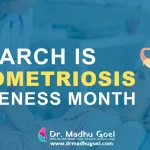Demystifying Myths and Facts Surrounding Cervical Cancer
Did you know? Cervical cancer, often preventable and treatable, is closely linked to the Human Papillomavirus (HPV). Cervical cancer originates in the cervix, the lower part of the uterus, with most cases caused by persistent infection with high-risk types of HPV, a sexually transmitted virus. Due to its susceptibility to HPV-related changes, regular screenings and vaccinations are crucial for maintaining cervical health. Understanding the realities of HPV and cervical cancer empowers individuals to prioritize their health, seek vaccination, and engage in regular screenings, contributing to global efforts to eradicate cervical cancer. Discover the truth about cervical cancer myths and facts with Dr. Madhu Goel, best Gynaecologist in New Delhi. Learn about common misconceptions and essential facts about cervical cancer prevention and treatment.
Dispelling Cervical Cancer Myths and Facts:
Myth 1: Only promiscuous individuals get HPV.
Fact: HPV is incredibly common and can affect anyone who is sexually active.
Myth 2: HPV always leads to cervical cancer.
Fact: Most HPV infections clear on their own, and only persistent infections pose an increased risk of cervical cancer.
Myth 3: HPV vaccines are only for teenagers.
Fact: HPV vaccines offer benefits to individuals of all ages, even those who have been sexually active.
Myth 4: Pap smears prevent cervical cancer.
Fact: Pap smears detect abnormalities early, but HPV vaccines provide primary prevention against cervical cancer.
Myth 5: Cervical cancer is not common.
Fact: Cervical cancer ranks among the most common cancers in women globally.
Myth 6: Only women need to worry about HPV.
Fact: HPV can affect all genders, and vaccination is recommended for individuals aged 9-65.
Myth 7: Cervical cancer has no symptoms.
Fact: Symptoms may include abnormal bleeding, pelvic pain, or unusual discharge.
Myth 8: Only individuals with multiple sexual partners get cervical cancer.
Fact: HPV transmission can occur even with a single sexual partner.
Myth 9: Condoms fully protect against HPV.
Fact: While condoms reduce the risk, they don’t eliminate it due to skin-to-skin transmission.
Myth 10: Cervical cancer is a death sentence.
Fact: Early detection and treatment significantly improve survival rates.
Myth 11: Older women can’t get HPV.
Fact: HPV can affect individuals of any age.
Myth 12: Vaccinated individuals don’t need Pap smears.
Fact: Both vaccination and regular screenings provide comprehensive protection against cervical cancer.
Myth 13: Natural remedies cure HPV.
Fact: There’s no cure for HPV, but vaccines prevent infection and related cancers.
Myth 14: Only individuals with a family history are at risk.
Fact: While family history can contribute, anyone with HPV exposure is at risk of cervical cancer.
Myth 15: Cervical cancer is untreatable.
Fact: Treatment options, including surgery, radiation, and chemotherapy, are available, especially in the early stages.
Schedule an appointment today for expert guidance and care.




